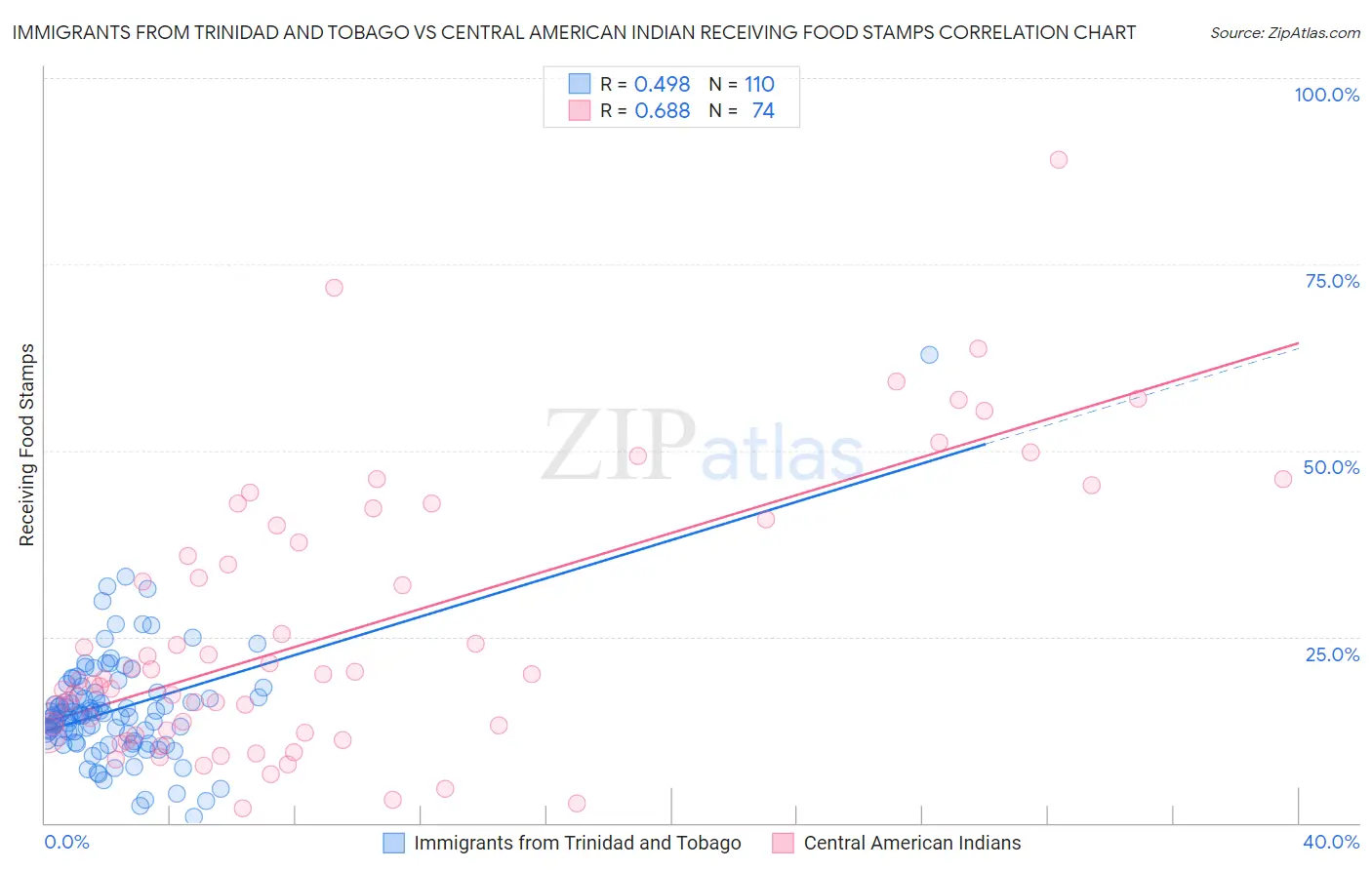Immigrants from Trinidad and Tobago vs Central American Indian Receiving Food Stamps
COMPARE
Immigrants from Trinidad and Tobago
Central American Indian
Receiving Food Stamps
Receiving Food Stamps Comparison
Immigrants from Trinidad and Tobago
Central American Indians
15.8%
RECEIVING FOOD STAMPS
0.0/ 100
METRIC RATING
298th/ 347
METRIC RANK
17.1%
RECEIVING FOOD STAMPS
0.0/ 100
METRIC RATING
316th/ 347
METRIC RANK
Immigrants from Trinidad and Tobago vs Central American Indian Receiving Food Stamps Correlation Chart
The statistical analysis conducted on geographies consisting of 223,195,672 people shows a moderate positive correlation between the proportion of Immigrants from Trinidad and Tobago and percentage of population receiving government assistance and/or food stamps in the United States with a correlation coefficient (R) of 0.498 and weighted average of 15.8%. Similarly, the statistical analysis conducted on geographies consisting of 325,864,154 people shows a significant positive correlation between the proportion of Central American Indians and percentage of population receiving government assistance and/or food stamps in the United States with a correlation coefficient (R) of 0.688 and weighted average of 17.1%, a difference of 8.1%.

Receiving Food Stamps Correlation Summary
| Measurement | Immigrants from Trinidad and Tobago | Central American Indian |
| Minimum | 0.90% | 1.9% |
| Maximum | 62.8% | 89.1% |
| Range | 61.9% | 87.2% |
| Mean | 15.2% | 25.9% |
| Median | 14.5% | 19.6% |
| Interquartile 25% (IQ1) | 11.2% | 12.1% |
| Interquartile 75% (IQ3) | 17.5% | 40.0% |
| Interquartile Range (IQR) | 6.3% | 27.9% |
| Standard Deviation (Sample) | 7.6% | 18.3% |
| Standard Deviation (Population) | 7.6% | 18.2% |
Demographics Similar to Immigrants from Trinidad and Tobago and Central American Indians by Receiving Food Stamps
In terms of receiving food stamps, the demographic groups most similar to Immigrants from Trinidad and Tobago are Immigrants from Bahamas (15.8%, a difference of 0.25%), Hispanic or Latino (15.8%, a difference of 0.28%), Immigrants from Bangladesh (15.9%, a difference of 0.71%), Trinidadian and Tobagonian (16.0%, a difference of 1.2%), and Immigrants from West Indies (16.1%, a difference of 2.1%). Similarly, the demographic groups most similar to Central American Indians are Bahamian (17.0%, a difference of 0.45%), Black/African American (17.2%, a difference of 0.53%), Immigrants from Guyana (16.9%, a difference of 1.0%), Immigrants from Jamaica (16.9%, a difference of 1.2%), and Sioux (16.8%, a difference of 1.5%).
| Demographics | Rating | Rank | Receiving Food Stamps |
| Immigrants | Bahamas | 0.0 /100 | #297 | Tragic 15.8% |
| Immigrants | Trinidad and Tobago | 0.0 /100 | #298 | Tragic 15.8% |
| Hispanics or Latinos | 0.0 /100 | #299 | Tragic 15.8% |
| Immigrants | Bangladesh | 0.0 /100 | #300 | Tragic 15.9% |
| Trinidadians and Tobagonians | 0.0 /100 | #301 | Tragic 16.0% |
| Immigrants | West Indies | 0.0 /100 | #302 | Tragic 16.1% |
| Nicaraguans | 0.0 /100 | #303 | Tragic 16.1% |
| West Indians | 0.0 /100 | #304 | Tragic 16.3% |
| Immigrants | Azores | 0.0 /100 | #305 | Tragic 16.4% |
| Jamaicans | 0.0 /100 | #306 | Tragic 16.4% |
| Houma | 0.0 /100 | #307 | Tragic 16.5% |
| Barbadians | 0.0 /100 | #308 | Tragic 16.5% |
| U.S. Virgin Islanders | 0.0 /100 | #309 | Tragic 16.5% |
| Immigrants | Barbados | 0.0 /100 | #310 | Tragic 16.6% |
| Guyanese | 0.0 /100 | #311 | Tragic 16.7% |
| Sioux | 0.0 /100 | #312 | Tragic 16.8% |
| Immigrants | Jamaica | 0.0 /100 | #313 | Tragic 16.9% |
| Immigrants | Guyana | 0.0 /100 | #314 | Tragic 16.9% |
| Bahamians | 0.0 /100 | #315 | Tragic 17.0% |
| Central American Indians | 0.0 /100 | #316 | Tragic 17.1% |
| Blacks/African Americans | 0.0 /100 | #317 | Tragic 17.2% |